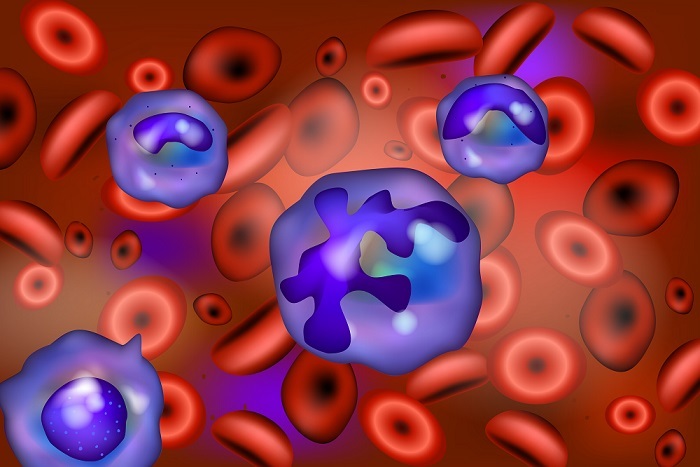
 Data Structure
Data Structure Networking
Networking RDBMS
RDBMS Operating System
Operating System Java
Java MS Excel
MS Excel iOS
iOS HTML
HTML CSS
CSS Android
Android Python
Python C Programming
C Programming C++
C++ C#
C# MongoDB
MongoDB MySQL
MySQL Javascript
Javascript PHP
PHP
- Selected Reading
- UPSC IAS Exams Notes
- Developer's Best Practices
- Questions and Answers
- Effective Resume Writing
- HR Interview Questions
- Computer Glossary
- Who is Who
Myeloblast Structure, Function, and Clinical Significance
Introduction
Myeloblasts are large, immature white blood cells that are derived from the myeloid lineage of hematopoietic stem cells. They are responsible for the production of granulocytes, which are a type of white blood cell that plays a critical role in the body's immune response. Myeloblasts are found in the bone marrow and are a key component of the body's immune system.
They are derived from the myeloid lineage of hematopoietic stem cells which are involved in defending the body against pathogens. Myeloblasts are characterized by their large, round shape and the presence of a large, round nucleus surrounded by a thin layer of cytoplasm.
While myeloblasts are not normally found in the peripheral blood of healthy individuals, their presence in the blood can indicate the presence of a serious underlying medical condition, such as acute myeloid leukemia (AML) or myelodysplastic syndrome (MDS). Early diagnosis and appropriate treatment are critical for achieving a good prognosis in these conditions.
Structure of Myeloblasts
Myeloblasts are large, round cells that range in size from 12 to 20 micrometers in diameter. They have a large, round nucleus that contains several nucleoli and is surrounded by a thin layer of cytoplasm. The cytoplasm contains numerous organelles, including mitochondria, ribosomes, and endoplasmic reticulum.

Myeloblasts are the earliest precursor cells of granulocytes, a type of white blood cell that plays an important role in the body's immune system. Myeloblasts are found in the bone marrow, where they differentiate into various types of granulocytes, including neutrophils, eosinophils, and basophils.
The structure of myeloblasts is characterized by their large size and round shape, which is like other immature blood cells, such as lymphoblasts. They have a large, single nucleus with finely dispersed chromatin and one or more nucleoli. The cytoplasm of myeloblasts is basophilic, which means it stains blue-purple with certain dyes and contains numerous azurophilic granules.
Azurophilic granules are lysosomes that contain various enzymes that are involved in the breakdown of cellular debris and foreign substances. Myeloblasts also have specific granules that contain proteins and enzymes involved in specific functions of different types of granulocytes, such as phagocytosis and the release of histamine.
Myeloblasts are part of the hematopoietic stem cell lineage, which means they differentiate into more mature cells through a process called myelopoiesis. During this process, myeloblasts give rise to promyelocytes, myelocytes, metamyelocytes, and finally, mature granulocytes.
In summary, the structure of myeloblasts is characterized by their large size, round shape, basophilic cytoplasm, and the presence of azurophilic and specific granules. These cells are the earliest precursors of granulocytes and play a crucial role in the body's immune system.
Function of Myeloblasts
Myeloblasts play a critical role in the production of granulocytes. Granulocytes are a type of white blood cell that is involved in the body's immune response. They are responsible for defending the body against pathogens, such as bacteria, viruses, and fungi.
When myeloblasts differentiate, they give rise to several different types of granulocytes, including neutrophils, eosinophils, and basophils. Each of these granulocytes has a specific function in the body's immune response.
Neutrophils are the most abundant type of granulocyte and are responsible for phagocytosing (engulfing and digesting) bacteria and other pathogens. Eosinophils are involved in the body's response to parasitic infections and are also involved in the development of allergic reactions. Basophils release histamine and other chemicals in response to allergens, causing inflammation and other symptoms.
Clinical Significance of Myeloblasts
Myeloblasts are not normally found in the peripheral blood of healthy individuals. However, in some cases, they may be present in the blood, indicating a serious underlying medical condition.
One such condition is acute myeloid leukemia (AML), a type of cancer that affects the bone marrow and blood. AML is characterized by the uncontrolled proliferation of myeloblasts, leading to a decrease in the production of healthy blood cells.
The presence of myeloblasts in the blood is a key diagnostic feature of AML. In addition to myeloblasts, individuals with AML may also have other abnormal cells, such as monoblasts, erythroblasts, and megakaryoblasts, present in their blood.
Treatment for AML typically involves chemotherapy and may also involve stem cell transplantation. Prognosis for individuals with AML varies depending on the age of the individual and the presence of certain genetic mutations.
In addition to AML, myeloblasts may also be present in the blood in other conditions, such as myelodysplastic syndrome (MDS), a group of disorders that affect the bone marrow and blood.
Conclusion
Myeloblasts are large, immature white blood cells that are responsible for the production of granulocytes, a type of white blood cell that plays a critical role in the body's immune response. The presence of myeloblasts in the blood can indicate the presence of a serious underlying medical condition, such as acute myeloid leukemia (AML) or myelodysplastic syndrome (MDS).
Diagnosis and treatment of these conditions often involve a combination of chemotherapy and stem cell transplantation. With early diagnosis and appropriate treatment, many individuals with these conditions can achieve remission and have a good prognosis.
It is important for individuals to be aware of the symptoms of these conditions and to seek medical attention if they experience any symptoms.

